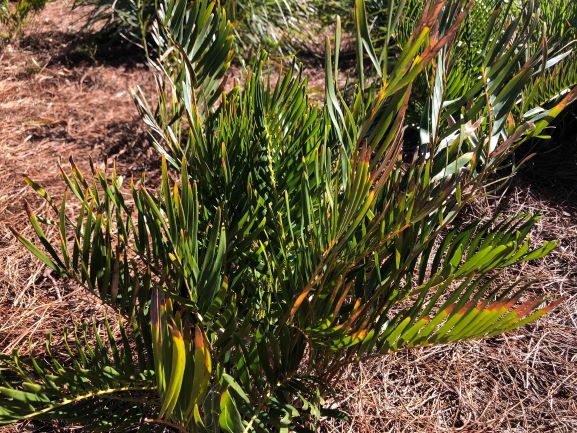
by Carrie Stevenson | Mar 11, 2021
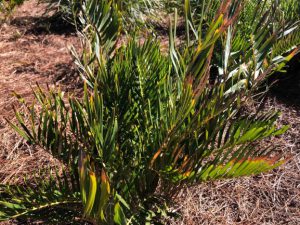
The ancient cycad, coontie, is a hardy and attractive plant for Florida landscapes. Photo credit: Carrie Stevenson, UF IFAS Extension
The plant has a crazy-sounding name, more like some little animal you’d find in Australia than a native plant. However, an ancient Florida plant it is, and a tough one at that. Growing close to the ground, it most resembles a large fern or a sago palm, if the sago had smooth, rounded leaf edges. Like the sago, the coontie (Zamia floridana) is a cycad—a group of palmlike plants that have been around so long that triceratops and stegasauruses ate them! Coonties are the only cycads native to North America, found in the states and island nations like Cuba and the Bahamas.
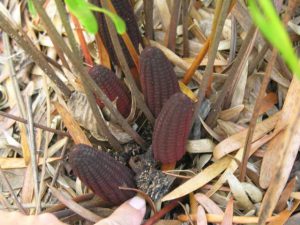
Male cones (strobilus) of coontie are thinner and shorter than female cones. Photo credit: Dan Culbert, UF IFAS
Another interesting feature of the coontie is its seed cones. These are large reddish orange cones that resemble magnolia seedpods. Both sexes of plant produce them in clusters ranging from one to five of the 2-7” long cones. Cones from the male produce pollen, while females produce seeds. If you are interested in attracting wildlife to your yard, the coontie provides good low-growing cover for birds and small mammals. It is also the preferred food for the caterpillar of the rare Atala butterfly. Members of the Timucuan and Calusa tribes ground up the starchy root of the coontie as a flour. However, the root contains a toxin and if it is not removed first, ingestion could result in severe abdominal pain and vomiting. From the late 1880’s through World War I, a large starch industry existed in Florida, producing flour from the coontie root.
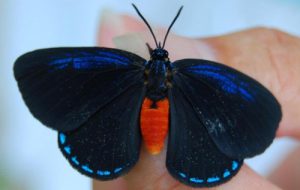
Adult female atala butterfly, showing royal blue streak on forewings. Photo credit: Sandy Koi, University of Florida
At home in drier soil conditions like oak hammocks and pinelands in north central Florida, these plants can also adapt to a variety of soil pH types. Coonties are drought, cold, and salt tolerant, thus a great landscape choice for coastal landscapes near the Gulf or a bay. The plants are very long-lived and adaptable. In fact, the book Florida’s Best Native Landscape Plants notes it is “Very hardy and easy to care for. Will grow well in any part of Florida, even outside its normal range. An exceptional replacement for the closely related, often used, but non-native sago palm.” In other words, this is an ideal landscape plant that should be used more throughout Florida.
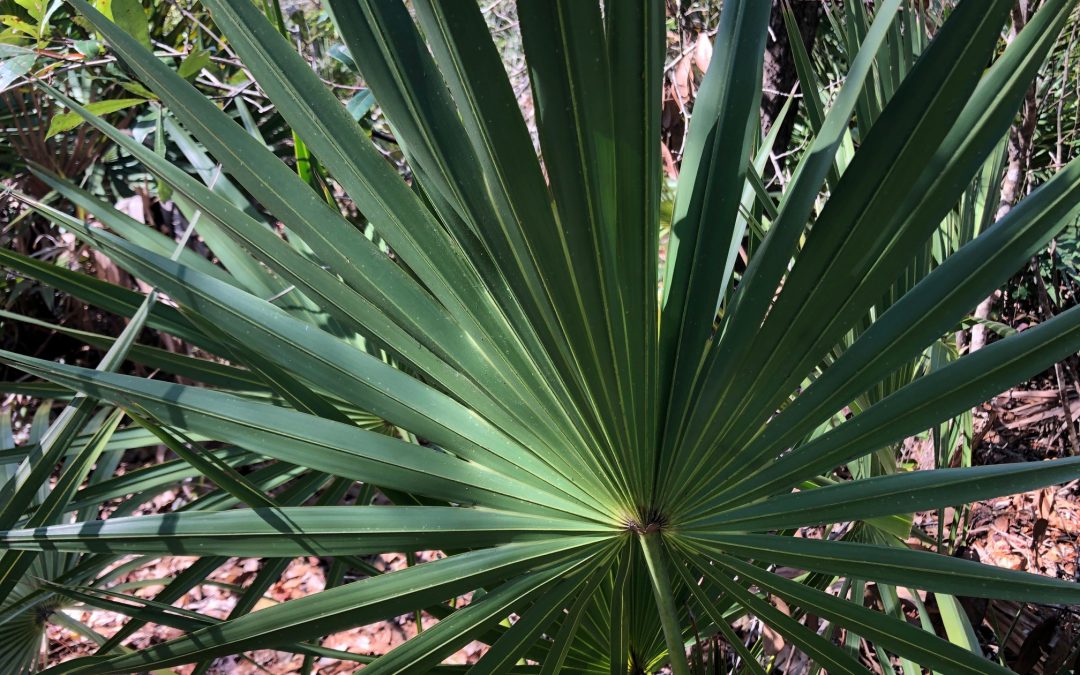
by Carrie Stevenson | Mar 4, 2021
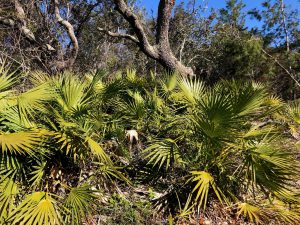
Saw palmettos provide crucial ecosystem services for the forests of Florida. Photo credit: Carrie Stevenson, UF IFAS Extension
The saw palmetto (Serenoa repens) is a classic symbol of Florida. Found in upland habitats and just to the edge of wetlands, their brilliant green fronds stand out in the mostly brown pine flatwoods and oak hammocks to which they are endemic. The shrublike saw palmetto thrives in sandy soils, is highly salt tolerant, and is tough as nails. The plant’s root is one of the sturdiest in nature. Imagine the trunk of a palm tree laid horizontally and just underground—this is the plant’s base. This root system lends stability and tolerance to nearly every tough Florida growing condition, including drought, floods, and fire. Saw palmettos are extremely slow growing, and there are stands in south Florida in which botanists have found individual plants and clonal colonies several thousand years old. Saw palmettos are one of the few members of the palm family that thrive in the panhandle. While many palm trees are planted here, most are native to more southern climates with warmer winters and karst geology—a higher pH soil composed of limestone and often prone to springs and sinkholes.
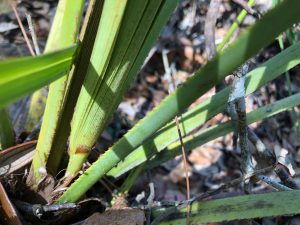
The tough, serrated edges of the saw palmetto gave it its name. Photo credit: Carrie Stevenson, UF IFAS Extension
The saw palmetto’s name comes from the serrated, saw-like edges of the stem. These are quite tough and can cut your skin and clothing if not careful. A very similar palmetto, the bluestem, grows in wetter soils. It can be differentiated from the saw palmetto because its stems are smooth—no serrated edges—and the whole plant has a bluish cast to it.
The saw palmetto has long been prized by humans for its practical uses. The “ethnobotanical” history of this plant has ties to Native American tribes who used the fronds for roofing and building material, brooms, fishing nets, and fans. The leaves were utilized for rope, and multiple plant parts for food and medicine. The dark blue/black fruit of the saw palmetto was considered an aphrodisiac and has been used to treat prostate problems for centuries. According to a UF publication on the saw palmetto, “Modern day development of a purified extract from the berries greatly improves symptoms of enlarged prostate. Florida is the biggest source and producer of saw palmetto products. With about 2,000 tons harvested from South Florida and exported to Europe each year, the fruit crop estimate is $50 million a year in the state.”
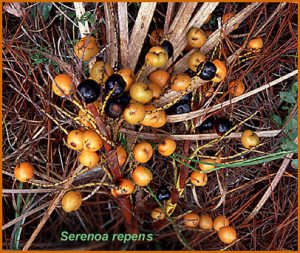
Saw palmetto berries are a staple of Florida wildlife diets. Photo credit: UF School of Forest Resources & Conservation
Besides the human uses, saw palmetto serves as a crucial component in the diet of native wildlife. Florida black bears, panthers, 20 other species of mammals, over 100 types of birds, 25 amphibians, over 60 reptiles, and countless insects depend on saw palmetto berries as part of their diet. The wild harvest of saw palmettos is regulated by the state to prevent overharvesting and negative impacts to the wildlife food supply.
Saw palmettos also make a great home landscape plant, as they can grow in a wide variety of conditions, provide wildlife food and habitat, and add visual interest. There are few plants more “low-maintenance” than an established saw palmetto. A mature one is so difficult to remove, that it’s best to leave it where it is anyway!
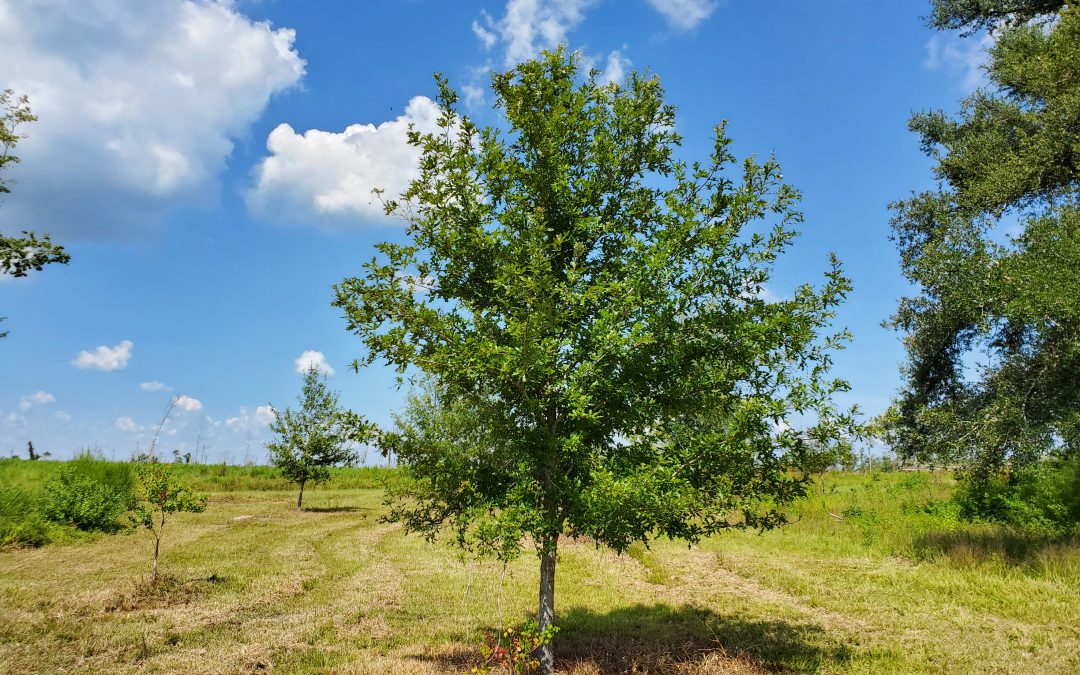
by Daniel J. Leonard | Sep 8, 2020
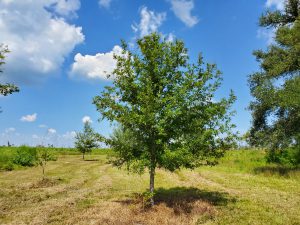
7 year old Overcup Oak (Quercus lyrata) on the edge of a wet weather pond in Calhoun County. Photo courtesy of Daniel Leonard.
Haunting alluvial river bottoms and creek beds across the Deep South, is a highly unusual oak species, Overcup Oak (Quercus lyrata). Unlike nearly any other Oak and most sane people, Overcups occur deep in alluvial swamps and spend most of their lives with their feet wet. Though the species hides out along water’s edge in secluded swamps, it has nevertheless been discovered by the horticultural industry and is becoming one of the favorite species of landscape designers and nurserymen around the South. The reasons for Overcup’s rise are numerous, let’s dive into them.
First, much of the deep South, especially in the Coastal Plain, is dominated by poorly drained flatwoods soils cut through by river systems and dotted with cypress and blackgum ponds. These conditions call for landscape plants that can handle hot, humid air, excess rainfall, and even periodic inundation (standing water). It stands to reason our best tree options for these areas, Sycamore, Bald Cypress, Red Maple, and others, occur naturally in swamps that mimic these conditions. Overcup Oak is one of these hardy species. Overcup goes above and beyond being able to handle a squishy lawn, it is often found inundated for weeks at a time by more than 20’ of water during the spring floods our river systems experience.
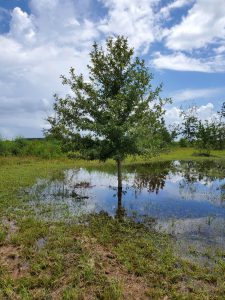
The same Overcup Oak thriving under inundation conditions 2 weeks after a heavy rain. Photo courtesy Daniel Leonard.
The species has even developed an interesting adaptation to allow populations to thrive in flooded seasons. Their acorns, preferred food of many waterfowl, are almost totally covered by a buoyant acorn cap, allowing seeds to float downstream until they hit dry land, thus ensuring the species survives and spreads. While it will not survive perpetual inundation like Cypress and Blackgum, if you have a periodically damp area in your lawn where other species struggle, Overcup will shine.
Overcup Oak is also an exceedingly attractive tree. In youth, the species is extremely uniform, with a straight, stout trunk and rounded “lollipop” canopy. This regular habit is maintained into adulthood, where it becomes a stately tree with a distinctly upturned branching habit, lending itself well to mowers and other traffic underneath without having to worry about hitting low-hanging branches. The large, lustrous green leaves are lyre-shaped if you use your imagination (hence the name, Quercus lyrata) and turn a not-unattractive yellowish brown in fall. Overcups especially shines in the winter, however, when the whitish gray, shaggy bark takes center stage. Overcup bark is very reminiscent of White Oak or Shagbark Hickory and is exceedingly pretty relative to other landscape trees that can be successfully grown here.
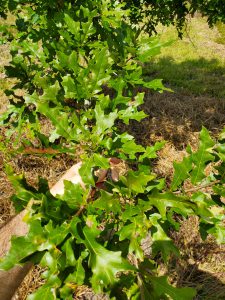
Overcup Oak leaves in August. Note the characteristic “lyre” shape. Photo courtesy Daniel Leonard.
Finally, Overcup Oak is among the easiest to grow landscape trees. We have already discussed its ability to tolerate wet soils and our blazing heat and humidity, but Overcups can also tolerate periodic drought, partial shade, and nearly any soil pH. They are long-lived trees and have no known serious pest or disease problems. They transplant easily from standard nursery containers or dug from a field (if it’s a larger specimen), making establishment in the landscape an easy task. In the establishment phase, defined as the first year or two after transplanting, young, transplanted Overcups require only a weekly rain or irrigation event of around 1” (wetter areas may not require any supplemental irrigation) and bi-annual applications of a general purpose fertilizer, 10-10-10 or similar. After that, they are generally on their own without any help!
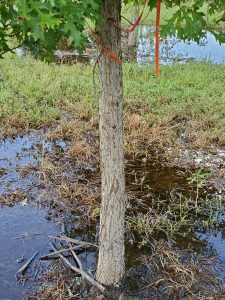
Typical shaggy bark on 7 year old Overcup Oak. Photo courtesy Daniel Leonard.
If you’ve been looking for an attractive, low-maintenance tree for a pond bank or just generally wet area in your lawn or property, Overcup Oak might be your answer. For more information on Overcup Oak, other landscape trees and native plants, give your local UF/IFAS County Extension office a call!
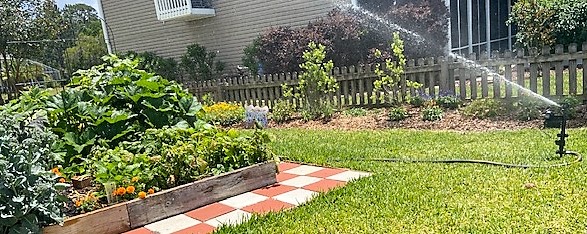
by Mary Salinas | May 14, 2020
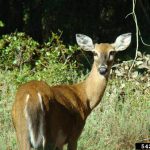
White tailed deer. Photo credit: Rebekah D. Wallace University of Georgia bugwood.org.
There doesn’t seem to be any shortage of deer in the panhandle, especially when it comes to them strolling in my yard looking for something tasty to eat. My vegetable garden suffered repeated assaults by hungry deer this past fall and winter. The garlic and cayenne pepper-based products only worked for a few days when freshly applied. I had to try something new this spring.
And my new method has worked. I purchased a motion activated high impact sprinkler that can be set to activate day or night. It has worked like a charm! There are various vendors but I purchased mine through a hardware store online for about $70. I put a splitter on my closest outdoor spigot and have a dedicated hose running to the sprinkler. This allows me to also have a regular hose for watering attached to the spigot. The hose must be turned on all the time. One problem that I am hoping to avoid this summer is that the water in the hose may get too hot in the summer heat and split the hose, so I am looking to maybe trench to keep the hose and the water inside a bit cooler.
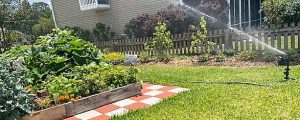
Motion activated impact sprinkler protecting the vegetable garden from ravenous deer. Photo credit: Mary Salinas, UF/IFAS Extension.
You can also choose plants that deer do not like to eat such as live oak, dogwood, muhly grass, coneflower and black-eyed Susan. However, keep in mind that when food is scarce deer will forage on plants that they normally would not eat. Southern magnolia is considered quite deer resistant but the one I planted this past winter was mostly defoliated by deer.
The University of Florida has a publication with many other strategies on controlling deer: Coping with Deer Damage in Florida.
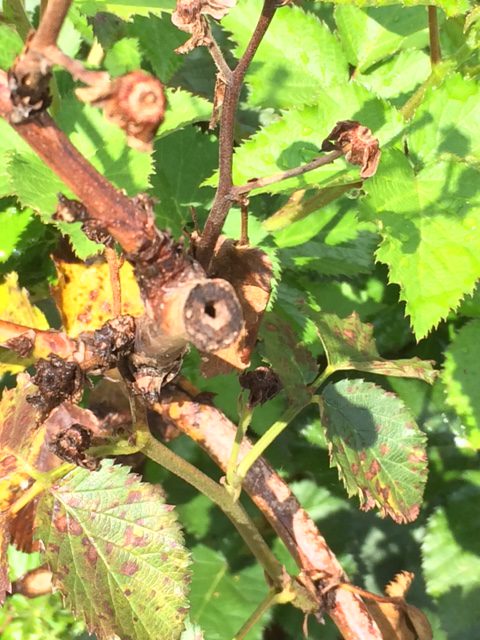
by Beth Bolles | Feb 27, 2020
Landscape activities have already begun in our Panhandle counties with cleanup, mulching, raking, and pruning. Our mild temperatures and days with sunshine spur us to jump into our landscape preparations for the spring growing season.
This year before you send all your debris to the compost pile or patch up thinning turf areas, consider that some landscape imperfections may actually be good for local wildlife.
We all know how important it is to plant nectar attracting plants for bees but there are other easy practices that can help promote more native bees in local landscapes. There are some solitary native bee pollinators that will raise young in hollow stems of plants. Instead of cutting all your old perennial or small fruit stems back to the ground, let some stay as a home to a native pollinating bee. This does not have to detract from the look of the landscape but can be on plants in the background of a border garden or even hidden within the regrowth of a multi stemmed plants. Plants that are especially attractive to native bees have a pithy or hollow stems such as blackberry, elderberry, and winged sumac.
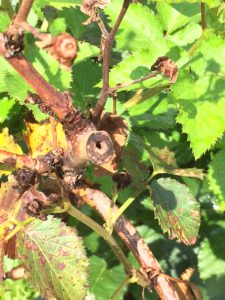
The hollow stems of upright blackberries can be home to solitary bees. Photo by Beth Bolles, UF IFAS Extension Escambia County
Another favorite site for solitary bees is in the ground. These ground nesting solitary bees should not be compared to yellow jacket wasps. Solitary bees are not aggressive. Mining or digger bees need some bare soil surfaces in order to excavate small tunnels for raising a few young. Maybe you have an area that does not need a complete cover of turf but is fine with a mixture of turf and ‘wildflowers’. A few open spaces, especially in late winter and early spring will be very attractive to solitary bees.
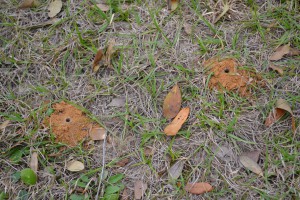
Beneficial solitary bee mounds in the ground of a winter centipedegrass lawn area. Photo by Beth Bolles, UF IFAS Extension Escambia County
One of our fastest disappearing homes for wildlife are natural cavities. In residential sites, we often prune or remove limbs or trees that are declining or have died. If the plant or tree is not a hazard, why not leave it to be a home for cavity nesting birds and mammals. If the dying tree is large, have a professional remove hazard pieces but leave a trunk about 10-15 feet tall for the animals to make a home. You may then get to enjoy the sites and/or sounds of woodpeckers, bluebirds, owls, flying squirrels, and chickadees.



















